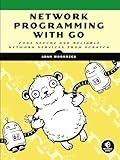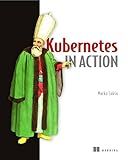Best Go Programming Guides to Buy in January 2026

Mastering Go: Leverage Go's expertise for advanced utilities, empowering you to develop professional software



System Programming Essentials with Go: System calls, networking, efficiency, and security practices with practical projects in Golang



Modern REST API Development in Go: Design performant, secure, and observable web APIs using Go's powerful standard library



Black Hat Go: Go Programming For Hackers and Pentesters
- MASTER GO PROGRAMMING FOR HACKING AND PENETRATION TESTING!
- GAIN ESSENTIAL SKILLS WITH AN ENGAGING, HANDS-ON APPROACH.
- PERFECT FOR HACKERS AND PENTESTERS-LEARN QUICKLY, APPLY EASILY!



Network Programming with Go: Code Secure and Reliable Network Services from Scratch



Kubernetes in Action



Go for DevOps: Learn how to use the Go language to automate servers, the cloud, Kubernetes, GitHub, Packer, and Terraform



Event-Driven Architecture in Golang: Building complex systems with asynchronicity and eventual consistency


In Golang, functions are defined by using the "func" keyword followed by the function name, the input parameters enclosed in parentheses, and the return type specified after the parentheses. Here's the syntax to define a function:
func functionName(parameter1 dataType1, parameter2 dataType2) returnType { // Function body // Code to be executed // Return statement if required }
For example, let's define a function called "add" that takes two integers as input and returns their sum:
func add(a, b int) int { sum := a + b return sum }
To use a function in Golang, you simply need to call it by its name and pass the required arguments. Here's an example of how you can use the "add" function:
result := add(2, 3) fmt.Println(result) // Output: 5
In this example, the "add" function is called with arguments 2 and 3, and it returns their sum, which is then printed using the "fmt.Println" statement.
Functions can also have multiple return values in Golang. To define a function with multiple return values, you need to specify the return types separated by commas. Here's an example:
func divide(a, b float64) (float64, error) { if b == 0 { return 0, errors.New("division by zero") } return a / b, nil }
In this "divide" function, we have specified two return types: a float64 and an error. If the second parameter "b" is zero, it returns an error, and otherwise, it returns the result of dividing "a" by "b" as a float64.
To call a function with multiple return values, you can capture each returned value in separate variables. Here's an example:
result, err := divide(10, 2) if err != nil { fmt.Println("Error:", err) } else { fmt.Println("Result:", result) }
In this example, the "divide" function is called with arguments 10 and 2. The result and the error are captured in the "result" and "err" variables respectively. If there's an error, it is printed, otherwise, the result is printed.
What is the purpose of the "panic" and "recover" mechanism in Golang functions?
The "panic" and "recover" mechanisms in Golang functions are used for handling exceptional situations or errors in the program.
- Panic: When a function encounters an error or exceptional condition that it cannot handle, it can call the built-in "panic" function. It immediately stops the normal execution of the program and starts the panic sequence. The panic function takes an argument, which can be of any type, to describe the reason for the panic. Panic will unwind the stack, running deferred functions and, eventually, halting the program. It is similar to throwing an exception in other programming languages.
- Recover: To handle the panic situation gracefully, Golang provides the "recover" function. It is used within a deferred function to catch a panic and resume normal execution. The recover function can only be called inside a deferred function; otherwise, it will have no effect. If no panic is currently occurring, the recover function returns nil. If recover is called within a deferred function during a panic, it stops the panic sequence, returns the value passed to the panic, and allows the program to continue executing from the point where the panic was triggered.
The panic and recover mechanism is especially useful in situations where the error cannot be handled locally, such as in top-level functions or Goroutines. It provides a way to propagate and recover from unexpected errors or conditions that would otherwise cause the program to terminate abruptly.
What are closures in Golang functions?
In Go programming language, closures are functions that reference variables from outside their body. They are created by defining a function inside another function and the inner function can access and modify variables from the outer function. These variables are kept alive even after the outer function has finished executing, as long as they are still being referenced by the inner function.
Closures are often used to create and return a function that has access to some initial state. They allow for encapsulation of data and behavior, similar to objects in object-oriented programming.
Here is an example of a closure in Go:
func counter() func() int { count := 0 // initial state
// the inner function is a closure
increment := func() int {
count++
return count
}
return increment // returns the inner function as a closure
}
func main() { c := counter() // c is a closure
fmt.Println(c()) // 1
fmt.Println(c()) // 2
fmt.Println(c()) // 3
}
In the above code, the counter function returns the increment function as a closure. The closure keeps track of the count variable from the outer function, and each time it is called, it increments and returns the updated value. The count variable remains accessible and its value persists between function calls.
How to define a function with parameters in Golang?
To define a function with parameters in Go, you need to specify the parameter types and names inside the parentheses after the function name. Here's an example:
func add(a int, b int) int { return a + b }
In this example, the function is named add and it takes two parameters: a and b, both of type int. The function will return the sum of these two integers.
You can also combine multiple parameters of the same type:
func multiply(x, y int) int { return x * y }
In this case, both x and y are of type int.
Once defined, you can call these functions by passing appropriate arguments:
result := add(3, 4) // result will be 7 product := multiply(2, 5) // product will be 10
Note that when defining a function with parameters, you need to specify the type for each parameter separately, even if they have the same type.
How to use closures in Golang functions?
In Go, closures are implemented as anonymous functions that can access and modify variables declared in their surrounding context. Here is an example of how to use closures in Go:
- Declare a function that returns another function:
func outerFunc() func() int { // Declare a variable in the outer function count := 0
// Define and return an anonymous inner function
return func() int {
// The inner function has access to the count variable
count++
return count
}
}
- Create an instance of the outer function:
counter := outerFunc()
- Use the returned function to access and modify the variables in the outer function's context:
fmt.Println(counter()) // Output: 1 fmt.Println(counter()) // Output: 2 fmt.Println(counter()) // Output: 3
Each time you call the counter() function, it increments and returns the count variable. This demonstrates how the closure "closes over" the count variable from its surrounding context and maintains its state across multiple invocations.
Closures in Go are commonly used for tasks like memoization, where a function is called with the same arguments repeatedly, and the previous result is returned instead of re-computing it.
